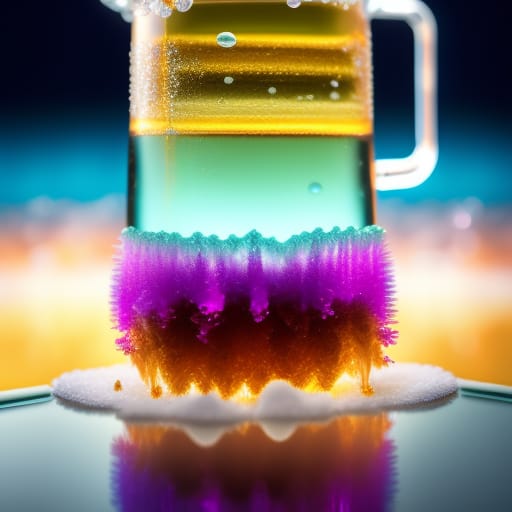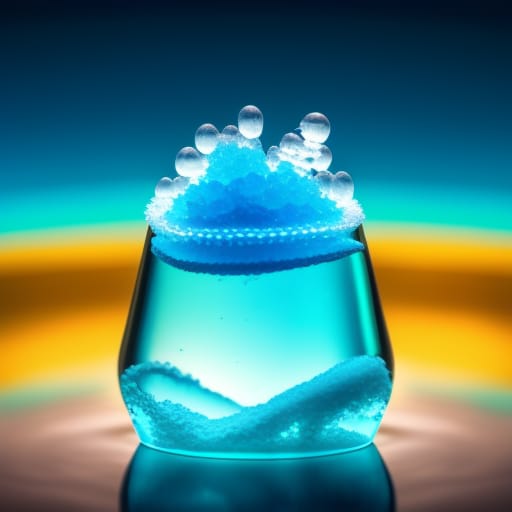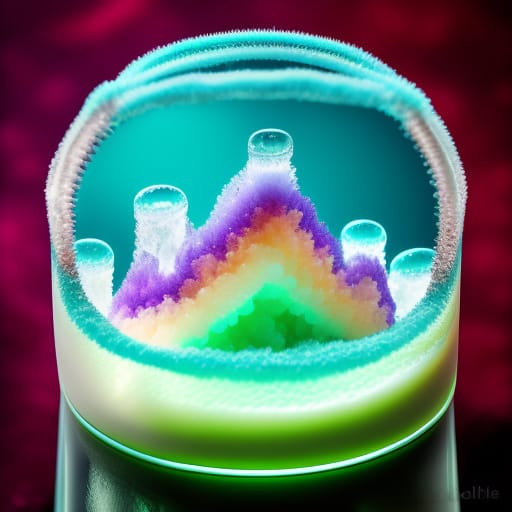Crystal growing is a fun and educational science experiment that allows you to learn about chemistry and crystallization. With just a few simple materials, you can grow beautiful crystals at home!
One of the most important factors in growing high-quality crystals is choosing the right container. The container holds the crystal solution and controls the crystal growth, so picking the best one for your needs is crucial.
In this beginner’s guide, you’ll learn:
- The different types of crystal growing containers
- Key factors to consider when selecting a container
- Crystal growing techniques and how the container affects them
- Helpful tools and accessories for your crystal project
- Safety tips for crystal growing at home
- Common mistakes to avoid
- Frequently asked questions about containers
Follow these tips to find the perfect vessel for growing awe-inspiring crystals!

Types of Crystal Growing Containers
There are several options when it comes to picking a container for crystal growing experiments. Here are some of the most common types and their key features:
Glass Containers
Glass jars, vases, and cups make excellent crystal growing containers because of their transparency. With glass, you can easily:
- Monitor crystal growth
- See the color
- Watch for evaporation
Glass also doesn’t interact with most crystal solutions. The main downside is glass breaks easily if knocked over.
Plastic Petri Dishes
Petri dishes are shallow cylindrical plastic containers often used in science. Key advantages include:
- Low-cost and widely available
- Transparent material allows viewing crystals
- Small size suits single crystal projects
- Reusable and durable
The shallow shape increases the evaporation rate, so you may need to refill the solution. Not ideal for large crystals.
Glass Jars
Glass jars like mason jars provide a classic option. Benefits include:
- Volume to grow multiple or large crystals
- Reusable and easy to clean
- Transparency to monitor crystal growth
- Wide mouths for inserting objects
May need to elevate smaller jars to prevent toppling. Lids can slow evaporation.
Saucers or Dishes
Ceramic saucers or plates present a cheap, simple container option.
Pros:
- Inexpensive and easy to find
- Allow open evaporation
Cons:
- Not transparent
- Can absorb crystal solution
- Too shallow for some projects
Terrariums
Glass terrariums or vivariums create a closed environment suitable for crystal growth.
Advantages:
- Seal in humidity to encourage crystal growth
- Interesting decorative piece
Disadvantages:
- Condensation can block views of crystals
- Limited access to crystals after sealing
- Higher cost than basic containers
Crystal Growing Materials
In addition to the container, you need to select the actual crystal growing material. Some common options include:
Alum Crystals
Alum powder makes beautiful crystals quickly.
Pros:
- Large crystals
- Grow overnight
- Low cost
Cons:
- Brittle
- Limited clarity and color
Borax Crystals
Borax forms hardy, gleaming crystals.
Pros:
- Clear, glassy crystals
- Durable
- Grow quickly
Cons:
- Can have cloudiness
- Brittle if too thin
Sugar or Rock Candy
Sugar crystals make a classic crystal growing project.
Pros:
- Edible when pure sugar is used
- Simple ingredients
- Can flavor and color
Cons:
- Slow growth
- Fragile crystals
- Can mold easily

Key Factors for Selecting a Container
When picking the best container for your crystal growing experiment, consider these key factors:
Size of the Container
- Small containers speed up evaporation for fast crystal growth
- Large containers allow bigger crystals to form
- Make sure the container is big enough for crystal-type
Shape of the Container
- Wide, open mouths provide access for adding seed crystals
- Deep vessels prevent spills and tumbling
Material
- Glass or plastic materials are best
- Avoid containers that react with solutions
- Transparent sides help monitor crystal growth
Evaporation Rate
- Open containers increase evaporation
- Lids can slow down evaporation as needed
- Match evaporation rate to crystal type
Crystal Growing Techniques
The container you select depends partly on the technique you use to grow crystals. Here are some common methods and container tips:
Evaporation Crystallization
This simple technique involves evaporating a heated crystal solution to encourage crystallization.
- Use a smooth-sided glass or plastic container
- Make sure the container is clean with no scratches
- Allow space at the top for evaporation
Seed Crystal Method
Adding a small “seed” crystal provides a template for further crystal growth.
- Choose a transparent container to monitor crystal growth
- Select a container with a wide mouth for easy access
- Match the size of seed crystals to the container
Suspension Method
Suspending an object in the solution allows crystals to form on the object.
- Pick a container wide enough to hold the suspended object
- Make sure the object fits easily into the vessel
Additional Tools and Materials
In addition to the main crystal growing container, some additional tools and materials can be helpful:
Distilled Water
Using distilled water avoids impurities affecting crystal growth.
Measuring Cup
Measuring ingredients precisely results in better crystal formation.
Spoons
Stirring helps dissolve crystal powder thoroughly.
Wax Paper
Lining containers with wax paper simplifies the removal of formed crystals.
Fishing Line
A fishing line can suspend objects in crystal solutions.
Safety Tips for Crystal Growing
Growing crystals is generally safe with supervision, but here are some basic safety tips:
- Use protective equipment like gloves and goggles
- Handle hot solutions carefully to avoid burns
- Follow instructions carefully, using exact measurements
- Dispose of materials properly when finished
- Keep small children away from crystal growing setup
With safe habits, you can avoid issues and enjoy the educational experience.

Common Crystal Growing Mistakes
It’s normal for beginners to encounter some problems when first growing crystals. Here are some common mistakes to avoid:
Using Tap Water
Tap water contains minerals and chemicals that interfere with crystal formation. Use distilled or filtered water only.
Overcrowding the Container
Don’t pack in too many seed crystals. This leads to small clustered crystals.
Incorrect Solution Concentration
Follow recipe instructions precisely to get the ideal saturation for crystals.
Moving or Jarring the Container
Crystal lattices are delicate. Protect them from vibration or disturbance.
Contamination
Keep equipment clean and avoid touching formed crystals to prevent deterioration.
Frequently Asked Questions
Here are answers to some common crystal-growing questions about containers:
How long does it take crystals to form?
Crystal growth time depends on factors like temperature, saturation, and the particular substance. Most take 1-7 days to form. Patience is key!
Can I reuse containers for multiple crystal growing projects?
Yes, most containers can be cleaned and reused multiple times. Just make sure to wash thoroughly after each use.
What’s the ideal temperature for crystal growth?
The best temperature is typically just below the boiling point of the solvent. For water solutions, aim for 180-212°F.
Conclusion
The container is one of the most important factors for crystal growth success. By understanding the different options and how containers affect crystal growth, you can pick the perfect vessel to produce stunning creations. Use this guide to select a container tailored to your specific project goals.
With the right materials and some patience as your crystals form, you’ll be rewarded with gorgeous, sparkling masterpieces. Growing crystals is an enjoyable way to learn about science and chemistry. Let your creativity shine by choosing containers with fun shapes, colors, and sizes. Share the wonders of crystal growth with friends and family!
Frequently Asked Questions
Here are answers to some common crystal-growing questions about containers:
How long does it take crystals to form?
Crystal growth time depends on factors like temperature, saturation, and the particular substance. Most take 1-7 days to form. Patience is key!
Can I reuse containers for multiple crystal growing projects?
Yes, most containers can be cleaned and reused multiple times. Just make sure to wash thoroughly after each use.
What’s the ideal temperature for crystal growth?
The best temperature is typically just below the boiling point of the solvent. For water solutions, aim for 180-212°F.
Can I use food coloring to dye the crystals?
Yes, adding a tiny amount of food coloring to the solution can create colored crystals. Start with just a drop or two to avoid over-coloring.
What kinds of string or fishing lines work best for the suspension method?
Use a monofilament fishing line or thin string made of nylon or polyester. Avoid cotton string as it may dissolve or discolor the solution.
Should I use tap water or distilled water in my crystal growing experiments?
It’s best to use distilled or filtered water to prevent impurities affecting crystal formation. Tap water contains minerals and chemicals that can interfere with crystallization.
How can I display my finished crystals in a display case or terrarium?
Carefully remove finished crystals using wax paper underneath. Place them in a display case lined with velvet or foam. For terrariums, leave the formed crystals in the container and seal the habitat.